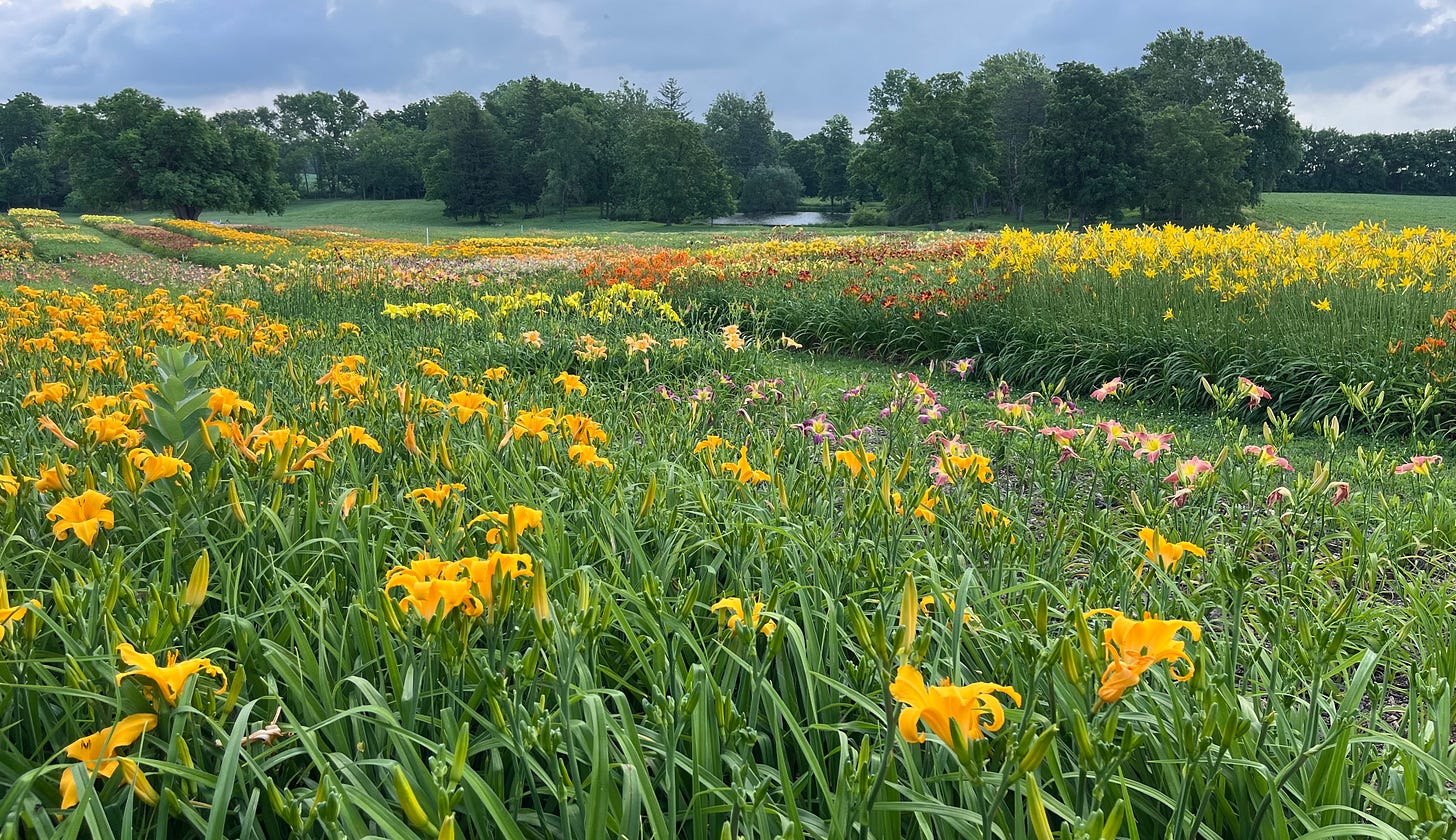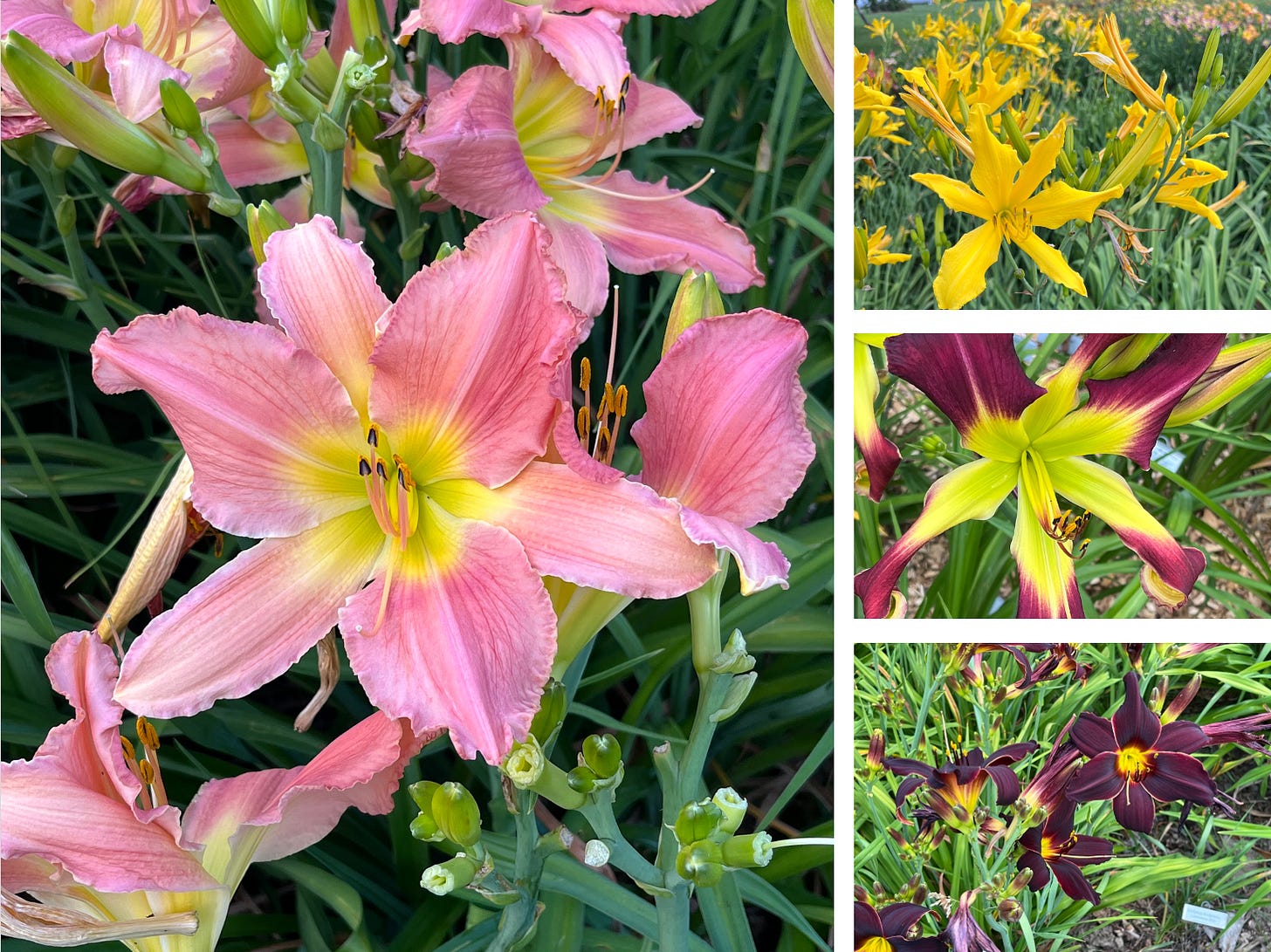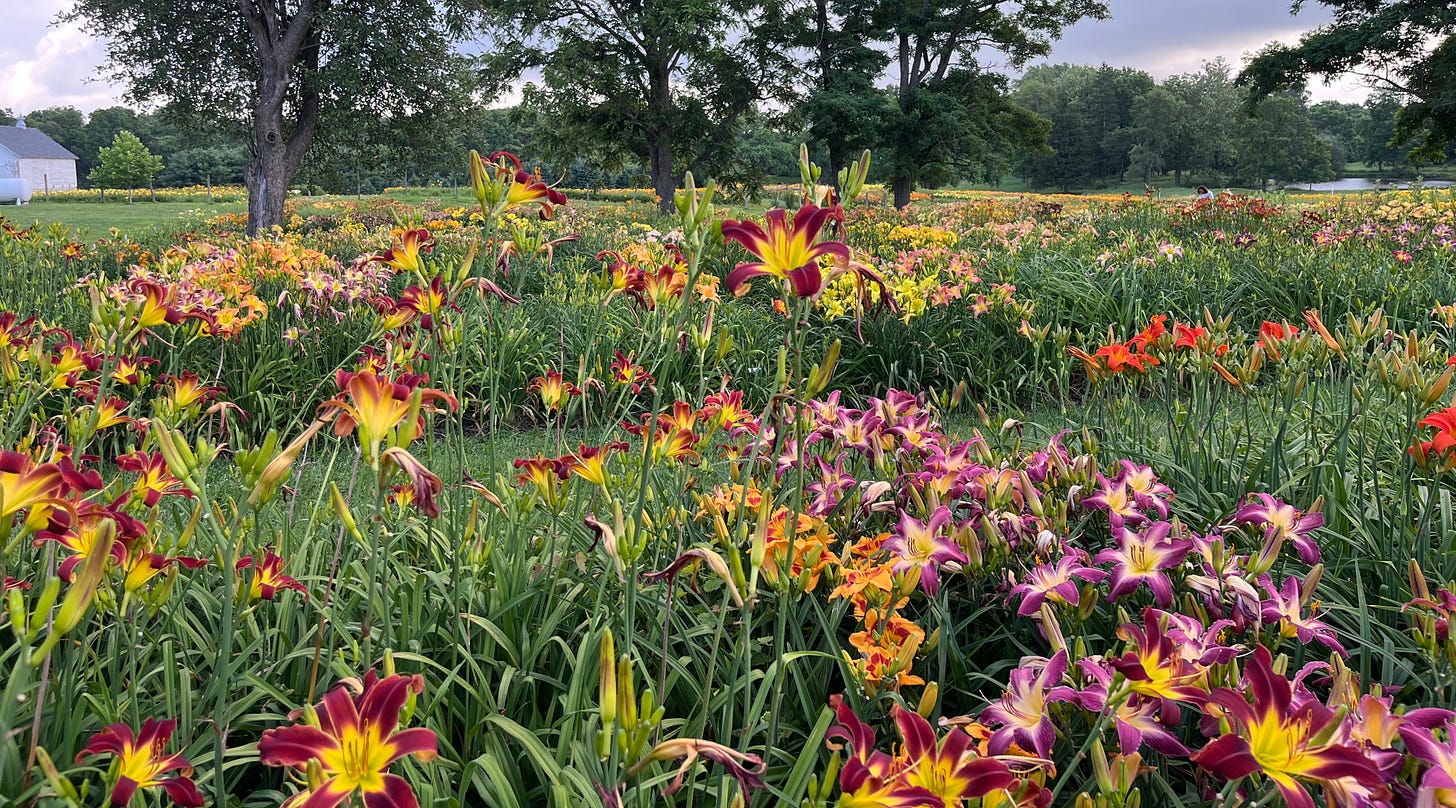You’ve seen the acres of daylilies along U.S. 52 South. Here’s a chance for a close-up
A Q&A with Gregg and Linda Sutter about the 1,500 daylily varieties at their farm, ahead of an Art Museum stroll/event there July 12. Plus: Lafayette’s backyard chickens proposal on hold another month
Support for this edition comes from the Wabash River Cycle Club, presenting the Wabash River Ride. On Aug. 23, the Wabash River Ride starts from Fort Ouiatenon. This event offers something for every cyclist, with both paved and gravel routes at 32, 62 and 100 miles. There is also a “Ride for All,” a 16-mile paved route for aspiring and veteran cyclists alike. Cyclists can expect well-stocked aid stations, a finisher’s meal, an adventure by bike and a welcoming environment! Registration is only $40 through July 31, after which is $45. Learn more about your next adventure at www.wabashriverride.com
First up: Today’s edition opens with the right assignment at the right time for Carol Bangert, who obviously knows way more about gardens than I ever will.
YOU’VE SEEN THE ACRES OF DAYLILIES ON U.S. 52 SOUTH. HERE’S A CHANCE FOR A CLOSE-UP
By Carol Bangert / For Based in Lafayette
It’s 9:30 a.m. and the daylilies on Gregg and Linda Sutter’s farm are already putting on a show, being all bright and bold and beautiful.
The 80-acre farm is home to 10 gently rolling acres of these vibrant perennials. The Sutters have been growing, collecting, transplanting, labelling and nurturing daylilies for more than 20 years, and the couple evokes the same joy and enthusiasm as the flowers they grow. Walking through the rows of oranges, reds, yellows, purples and pinks, one can’t help but be pulled in by the riot of color. The soundtrack provided by orioles, song sparrows and robins is punctuated by excited declarations:
“Gosh, is that a beautiful plant!”
“How does it get any prettier than that?”
“This one is absolutely phenomenal!”
“Let’s face it. They’re all pretty!”
Gregg Sutter estimates that he has more than 1,500 daylily varieties on his farm, with names as colorful as the plants: Persian Ruby, Primal Scream, Russian Easter, Yazoo Jim Terry, Ruby Spider, Lusty Leland and Dancing with Giraffes. And the Sutters pretty much know where each of those varieties is growing in the expanse of nonstop color.

The farm, located south of Lafayette near Clarks Hill, and home to the Sutters’ 1848 farmhouse, will be the venue for a daylily stroll on July 12, hosted by the Art Museum of Greater Lafayette, where the daylilies will be at their peak of color and blooms.
Here, Gregg and Linda Sutter share detail about the hobby that’s “gotten a little crazy.”
Question: Where did the interest in daylilies begin?
Gregg Sutter: I developed subdivisions, and 20-25 years ago, I went into Bennett's and asked them if they had any type of plant that I didn't have to water, weed, fertilize or take care of, and they mentioned daylilies and about three other plants. At that time, we had a cottage up on Lake Freeman, and I was driving up there, and a Monticello radio station had a trading show or something. So, this lady gets on and says, “Hi, my name's Irene Stevenson, and I sell daylilies. You come to my house and I'll fill your car.” I thought, wow! What a deal. She lived in Idaville, and we had a Chrysler minivan at the time. And, I mean, I filled the minivan. She would just sell by clumps. I'd fill the car, and I'd bring them home, and then I'd go back. I think the first year I might have had six car loads, maybe $3 a clump.
Linda Sutter: She was very generous, and she liked Gregg a lot. She would always throw in a couple extra. You were a good buyer.
Gregg Sutter: We had no gardens at that time, period. Nothing. Well, Linda had flower beds. And so we were standing in the driveway and looking in the barn lot. “Let's put them in the circle.” That was the first bed, the circle. Those are the originals. You know, it's kind of sacred.
Question: Over the past 25 years, then, you’ve seen a lot of changes in daylilies and hybrids. Talk about that.
Gregg Sutter: You know, it's all about a pretty face with me, OK? And the newer hybridizers, it's such a different deal. I mean, obviously everybody wants the prettiest plant, but I think they get more hung up on what the bud count is and the branching and the height. They want something that's sturdy and it's way above the ground. The older varieties are lower to the ground. The new varieties are more elaborate, you know, the blossoms have ruffles, and (the hybridizers) can make it look tiger-ish or different coloring, all sorts of shading.
Question: A lot of gardeners, myself included, avoid daylilies, mainly because the belief is they bloom, they’re done and that’s it. But that’s not the case, is it?
Gregg Sutter: Well, you know, if you have one stem coming up, then you have a traditional daylily. A lot of them, really, only are seven per stem, seven blossoms. That's the older variety. Now the newer variety, we're talking up to 24 blossoms. They keep blooming.
Linda Sutter: And some are blooming now, late bloomers start in late July and some will have a fall bloom. You’ll have continuous blooms all season.
Question: When are daylilies at their peak? What is the growing season like?
Linda Sutter: Oh, we have the first one every year, called Early Anna. And that's around May 26, around Memorial Day. And then we have blooms from then until it freezes.
Gregg Sutter: Probably the first or middle of June, they start coming on big through August or mid-September. I saw a bloom almost up to December last year.
Question: From what I’ve read, a lot of daylily growers are hybridizers. That seems to be a big thing. But you are not. Why not?
Gregg Sutter: It's interesting. I mean, there were a few hybridizers years ago, but since we've been doing this, I think it's taken a real turn. We're a member of two or three daylily clubs, and I think we are one of the only people that do not hybridize. All my friends are hybridizers, and we now have a hybridizer using part of our land.
Some of these (new hybrids) are so over-the-top beautiful, but the plant isn’t winter hardy, you know? And so, I've got the newest and greatest, but the newest and greatest, I mean, it's like when I started out. I was buying $3 a clump. Right now, if I would buy the new introductions, they're like, a minimum, $150 a plant.
There are some that are $400. And when you have a hybrid, it takes seven years before you have enough to sell. And even then, the hybridizer may decide not to introduce it. I have some of those, and I wonder, “Why would they not introduce this?”
Question: You’ve said that one of the reasons you wanted to grow daylilies is that they are low maintenance. In what way? And what does a high-maintenance day look like?
Gregg Sutter: Daylilies are pretty hardy and we do not water and we don’t fertilize. I have five people working for me in the daylilies. The secret is mulch, but my problem is I don't want weeds. Before they can mulch, they have to pull the weeds, right? So, in April when the daylilies are just coming out of the ground, they start weeding. It's so easy to eliminate the weeds then. After that, we mulch. Mulch is a secret because, yes, a weed will go through the mulch, but it deters it. I contract with a fellow in town that does a tree service, and I get mulch from him by the truckload. I don't want to know how much I’ve used. But we will be weeding, tidying beds, mulching and mowing every day during the summer. There’s something to do out here every day. Then in the fall and winter, we pull the dead stems, which takes a long time, divide and transplant.
Question: The farm stands out among all the farmland and is stunning from the road. Do people just pull in to see what’s going on?
Gregg Sutter: People always pull in the driveway. I mean, we're always afraid that we're going to have somebody get hurt, because people drive down the road and they put on their brakes, and the next one's doing the same thing, and they might run into each other. I don't have a sign up that says “Slow, daylilies,” or something like that, because it's a danger. But here again, most people who like plants are nice people. A lot of people want to buy them, but I don’t want to get into selling them.
Question: You’ve been doing this for more than 20 years, and I know you’ll laugh at this question, but do you have any idea how many actual plants you have?
Gregg Sutter: No idea! But I have 1,500 daylily varieties.
Question: You clearly are very knowledgeable about daylilies. Is this something you learned from research and reading, or something you picked up along the way?
Gregg Sutter: It’s all trial and error.
Question: Last question. Do you have a favorite daylily?
Linda Sutter: Yes, I have one. It’s called Linda Sutter. It is a registered hybrid named after me by Curt Hanson, a hybridizer in Ohio. It’s medium sized with ruffled edges and a pink blossom.
Gregg Sutter: I Lava You is one of my favorites. It’s a pretty red one. But let’s face it, they’re all pretty.
IF YOU GO
The Art Museum of Greater Lafayette will host A Daylily Stroll from 10 a.m.-2 p.m. Saturday, July 12, at Gregg and Linda Sutter’s farm, 10547 U.S. 52 South, Clarks Hill. The event features light refreshments and live music by Velocity District. Treat Your Selfie will be on-site to help capture the day, and plein air painters and artists are invited to create among the flowers. Timed entry: 10–11 a.m., Art Museum of Greater Lafayette Second Century, Board Members and Community Partners; 11 a.m.-noon, Museum and Art League Members; Noon–2 p.m., general admission: For more details and to RSVP, here’s the link.
Like what you’re reading in Based in Lafayette? Now’s the time to subscribe to get it straight to your inbox. Free and full-access options are available here …
THIS AND THAT/OTHER READS …
LAFAYETTE’S BACKYARD CHICKEN PROPOSAL ON HOLD ANOTHER MONTH: Not on the agenda Lafayette City Council’s monthly meeting Monday, July 7: Backyard chickens. Eileen Hession Weiss, a city council member who this spring held a series of meetings on a proposal that would allow residents to keep hens, said at least one council member will not be at the July meeting “and we wanted all of the council members to be able to vote on this ordinance.” She said council members will hold a work session July 21 to discuss the proposal before she files the draft ordinance for formal consideration.
“Since it is such a public issue, we wanted to make sure that everyone's concerns or questions are addressed before they have to take a final vote,” Hession Weiss said this week.
A draft proposal of an ordinance presented in April would allow households to have up to five hens, but no roosters, for noncommercial use. It also laid out proposed requirements about chicken coops, care and maintenance of the birds and their surroundings, and a fine structure for violations.
The current Lafayette City Code prohibits keeping or breeding a long list of livestock in city limits, including “a horse, pig, pony, mule, donkey, jackass, goat, chicken, peacock, turkey, cow, llama or other livestock.” The city code says those restrictions do not apply to zoos, “bona fide circuses or carnivals.”
A pair of public sessions this spring were dominated by fans of the idea, including support from the city’s chief animal control officer, who pointed out benefits of having fresh eggs, educational opportunities for kids and the fact that Lafayette would be joining a list of other cities that allowed chickens, including West Lafayette. But during one of those sessions, several city council members indicated they still had questions about whether rewritten city code should address additional questions about care of the birds, how to handle abandoning chickens by people whose initial excitement wanes once they get into the hobby and whether to allow backyard butchering when a hen’s egg-laying days are done.
The earliest the backyard chicken ordinance could go on a council agenda now is Aug. 4.
SENTENCING IN CASE INVOLVING CHILD SHOOTING HIS 1-YEAR-OLD BROTHER: J&C reporter Ron Wilkins had the details as Deonta Johnson, 29, of Lafayette, was sentenced for neglect in connection with the 2023 shooting death of his 1-year-old son when the boy’s 5-year-old brother found a gun in their Lafayette apartment. Shatia Welch, the boys’ mother, was sentenced to six years in prison earlier this year on neglect charges. Here's how it played out for Johnson Wednesday in Tippecanoe Superior Court 2: “Father of 1-year-old killed by his 5-year-old brother will spend 24 years in prison.”
ABOUT BRAUN’S ENVIRONMENTAL EXECUTIVE ORDERS: This comes from Whitney Downard reporting for the Indiana Capital Chronicle: “The Indiana Department of Environmental Management identified a handful of regulations that could clash with a gubernatorial order to eliminate “unduly burdensome” or costly rules, though nearly all of them appear to be relatively minor tweaks. Still, Sam Carpenter, executive director of the Hoosier Environmental Council, said Gov. Mike Braun’s mandate to review the agency seems like a decision that ‘environmental protections are bad for businesses before really, fully understanding and researching the issues. … We just need to keep in mind that protections are in place because, often, an event has occurred and we realized that the protections that were currently in place were not sufficient.’” Here’s the rest of the story: “Environmental agencies, advocates respond to Braun executive orders. Governor’s actions reflect larger approach to regulation, say some.”
BIGGER LIGHT SHOW IN THE GRASS: Axios reporter Arika Herron writes: “ You're not imagining it. Fireflies are having a good year.” If your yard is anything like our yard, the fireflies really are going nuts. Writing from Indianapolis, Herron looks into it: “Why you're seeing more fireflies.”
Thanks, again, for support for this edition from the Wabash River Cycle Club, presenting the Wabash River Ride on Aug. 23. Learn more at www.wabashriverride.com.
Thank you for supporting Based in Lafayette, an independent, local reporting project. Free and full-ride subscription options are ready for you here.
Tips, story ideas? I’m at davebangert1@gmail.com.









Love the article about the daylilies. the name of the lady referenced was my grandmother, and her name was Irene Stevenson (not Stevens) and she lived north of Burnettsville (not Idaville). My parents have her farm now and there are still a few of her daylilies left.
Thanks for the lovely article and great pictures of the Day Lilly farm of 52. Your story is a wonderful verification that Lafayette is a beautiful place to live.